In our rapidly evolving world, staying updated with the latest advancements and regulations is crucial for employers, managers, and business owners. This comprehensive guide offers insights into best practices for respecting and supporting transgender employees, ensuring their rights are upheld. Employers will learn to address potential issues and support transgender and gender-nonconforming employees by fostering a safe and welcoming work environment. Implementing these practices will empower employers to create an equitable workplace free from discrimination and harassment.
Recognize that by taking these steps to ensure inclusivity, you contribute significantly to creating a better workplace and society. Your efforts in fostering inclusivity are commendable and crucial for positive change.
What You’ll Find In This Guide
This guide offers insights, resources, and strategies for creating a workplace environment that is inclusive of transgender/gender-nonconforming employees. Implementing the suggestions in this guide represents an employer’s commitment to fostering a culture of equity and respect. Here are some of the topics you’ll find in this guide for employers who are looking to create a more inclusive workplace for their transgender/gender-nonconforming employees:
- How to make sure that your policies and procedures reflect the latest state and federal laws related to transgender rights and protections.
- How to provide training to staff on how to interact respectfully with transgender colleagues.
- How to ensure that transgender/gender-nonconforming employees have access to resources and support systems.
- How to make sure that transgender/gender-nonconforming employees have a safe and confidential space to report any incidents of harassment or discrimination.
- How to create an environment where transgender/gender-nonconforming employees feel included and respected
This guide captures the essential elements of improving your workplace culture to be more trans-inclusive. However, this initiative requires more than just having the right policies in place. Proper training for staff on supporting and interacting with transgender colleagues is essential. This includes training on transgender rights and protections, and the use of gender-neutral language. Employers should also ensure that staff are aware of available resources and support systems for transgender employees.
Evolving interpersonal workplace relationships also require employers to make sure that their staff is aware of any resources or support systems that are available to transgender employees. This could include providing transgender employees with access to gender-affirming healthcare or offering mental health services for transgender employees. It’s also important for employers to make sure that their staff is aware of any employee assistance programs or other services that can provide transgender employees with additional support. This guide provides some helpful legal and management resources and recommendations. While creating a trans-inclusive workplace can be challenging, it should never be an inconvenience. This guide smooths the road for your journey to managing an equitable, inclusive, and profitable business.
Table of Contents
Why Inclusivity For Trans/Gender-Nonconforming Folks Is Essential To Workplace Equity
Transgender inclusion in the workplace is essential to creating a more equitable and diverse working environment. This is not only the right thing to do, but it is also beneficial to businesses in the long run. A McKinsey & Company study showed that companies in the top 25% for racial/ethnic and gender diversity were, respectively, 36% and 25% more likely to have superior financial returns. Supporting trans/gender-nonconforming individuals in feeling welcome and respected in the workplace can help create a more positive and productive environment, leading to better performance and increased revenue. Additionally, creating an inclusive workplace helps to foster a culture of respect and acceptance that can attract and retain talented employees who may otherwise be excluded. Rather than lose the unique perspectives of these valuable employees, subject matter experts, leaders, and other personnel, creating a trans-inclusive workplace retains talent and builds institutional knowledge. Finally, by taking steps to create a more welcoming and affirming workplace, organizations can demonstrate their commitment to diversity and equality, setting an example for other organizations to follow.
What Does It Mean To Be Transgender/Nonbinary/ Gender-Nonconforming?
Transgender is an umbrella term for individuals whose gender identity and/or gender expression are different from the gender they were assigned at birth. “Trans” is sometimes used as a short form for transgender.
A person’s gender identity represents a feeling about one’s place in the world, how they want to be seen, and how they interact with the world in ways of masculinity, femininity, a combination of both, or neither. Gender expression/presentation is how a person communicates their gender identity to the world (an outward expression of their gender versus an inward sense of self). This is done through their style of dress, behavior, tone, and any other outwardly visible characteristics.
Although ‘transgender’ is generally a good term to use, not everyone who falls under the gender-nonconforming umbrella identifies with the label of transgender. Some people identify as nonbinary, meaning they have a gender identity that is not 100% male nor female – they might consider themself somewhere on a spectrum of masculinity to femininity, outside the spectrum altogether, having multiple genders, or perhaps their gender identity/expression or intensity of which they experience gender fluctuates over time. The transgender community is quite varied, consisting of different people with diverse backgrounds, life stories, and beliefs. How transgender people are discussed in social and academic circles is constantly changing as people become more and more knowledgeable and accepting of transgender individuals and their journeys.
What It’s Like To Be Trans In The Workplace
Being transgender in the workplace can be a challenging and sometimes dangerous experience, even in the most progressive of workplaces.
From the moment a transgender person steps in the door, they will often face a barrage of invasive questions about their gender identity. This can be especially difficult for those who are transitioning, who may already be feeling vulnerable and exposed. Additionally, transgender employees often experience discrimination in the form of exclusion from workplace activities and conversations or subtle forms of harassment such as misgendering (deliberately or inadvertently using the wrong pronoun). In more extreme cases, transgender individuals may be subjected to physical violence. It’s also important to recognize that transgender people often face unique challenges in terms of healthcare and other benefits.
For example, many insurance plans still have exclusions or limits on healthcare services related to gender-affirming care. This can be a major source of stress and anxiety for transgender employees, who may feel like they are unable to access the care they need.
Common Experiences Shared By Transgender Employees
The workplace can be a challenging environment for transgender people, with many facing discrimination, microaggressions, or even legal repercussions for expressing their gender identity. As an employer, it is important to understand the unique challenges faced by transgender people in the workplace and to create a safe and inclusive environment for all.
Misgendering
Misgendering is when a person is referred to using language which does not reflect their gender identity. For example, if a person is transgender and identifies as female but is referred to as “he” or “him,” then this is an example of misgendering. This can be an incredibly distressing experience for transgender people, as it invalidates their gender identity and can make them feel disrespected or misunderstood. It is important that employers take steps to ensure that all employees are referred to in a way that matches their gender identity. This includes using the correct pronouns when addressing employees, as well as using the employee’s chosen name. This also applies to any written documentation, such as emails or contracts. Employers should also ensure that all employees are aware of the correct way to address each other in the workplace.
Deadnaming
Deadnaming is when a person’s former name is used instead of their chosen name (read as: their real name). It can be a distressing experience for transgender people, as it can be a reminder of their former identity, which can be difficult to reconcile with their gender identity. It is important for employers to take steps to ensure that all employees are referred to by their chosen name. This includes using the correct name in all written documentation, such as emails and contracts. Employers should also ensure that all employees are aware of the correct way to address each other in the workplace.
Transgender Discrimination
Transgender discrimination is when a person is treated differently or unfairly because of their gender identity. This can include being denied a job or promotion, being unfairly disciplined, or being excluded from workplace activities. Additionally, transgender people may also experience harassment or bullying in the workplace. Transgender discrimination is illegal in most countries, and employers should take steps to ensure that all employees are treated with respect and that discrimination is not tolerated. Employers should also create clear policies and procedures to protect transgender employees from discrimination or harassment.
Gender Euphoria
A feeling of comfort, confidence, happiness, peace, or excitement relating to one’s body and/or identity. Gender euphoria can arise as a result of being gendered correctly, having a gender-affirming procedure, reaching a milestone in one’s transition, or wearing clothes that affirm one’s gender. Other things that can cause Gender Euphoria are self-care, being seen as one’s authentic self, receiving a gift that affirms one’s gender, talking on the phone, going to the mall, or anything else that makes someone feel feminine/masculine/androgynous/etc.
Gender Dysphoria
Gender dysphoria is a condition that causes distress or discomfort when a person’s gender identity does not match their assigned sex at birth. It can be a difficult and distressing experience for transgender people and can lead to feelings of isolation or anxiety. It is important that employers take steps to ensure that transgender employees are supported in the workplace. This includes providing access to gender-affirming healthcare and creating a safe and supportive environment for transgender employees. Employers should also consider providing training to staff on understanding and supporting transgender people in the workplace.
Microaggressions
Microaggressions are subtle forms of discrimination that can be experienced by transgender people in the workplace. This can include being misgendered, deadnamed, or excluded from workplace activities. These experiences can be subtle and hard to identify but can have a significant impact on transgender people in the workplace. Some common types of microaggressions are comments such as:
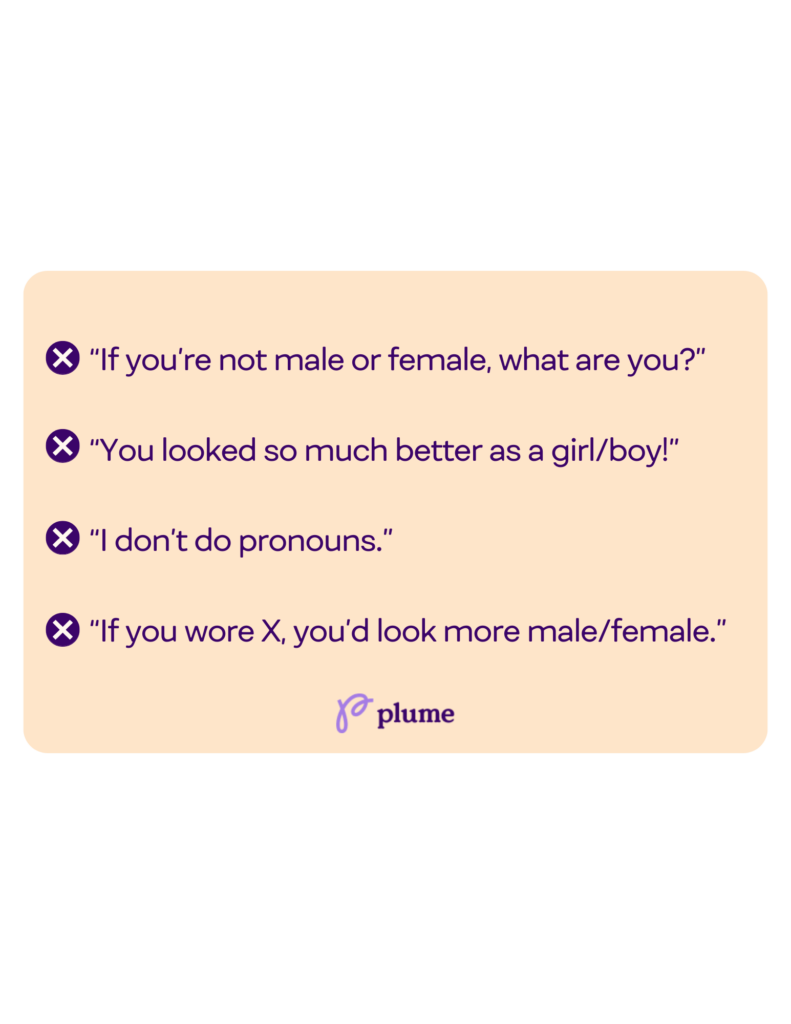
Other types of harassment are backhanded compliments, such as “You look really good for a trans person.” It is also common for coworkers to persist in using improper language to harm and dehumanize some.
It is totally fine and appropriate to say something like “Rowan is a transgender person,” but not “Rowan is a transgender” or “Rowan is transgendering.” It is important that employers are aware of the subtle forms of discrimination that can be experienced by transgender people in the workplace and take steps to ensure that all employees are treated with respect. Employers should also consider providing training to staff on understanding and supporting transgender people in the workplace.
By understanding the unique challenges faced by transgender people in the workplace, employers can better create a safe and inclusive environment for all employees. Transgender inclusion is essential to workplace equity. By educating yourself and your team about this challenge, you’re doing the right thing! With the right support and understanding, employers can ensure that all employees are respected and valued in the workplace.
Policies And Procedures That Facilitate A Transgender-Inclusive Workspace
One of the most effective ways to create a transgender-inclusive workspace is to develop policies and procedures that reflect the organization’s commitment to equity and respect.
This includes having a clear policy against any forms of discrimination or harassment based on gender identity or expression. It is also important for employers to create an environment where transgender employees feel safe and supported. This means having access to gender-neutral bathrooms and providing training to staff on how to respectfully interact with transgender colleagues.
Additionally, employers should make sure that their HR policies are up to date with the latest state and federal laws related to transgender rights. For example, in many states, employers are now required to provide transgender employees with access to gender-affirming healthcare.
Inclusive Language
We have come a long way in creating a workplace culture that is equitable and safe for everyone, but there is still more work to be done. Employers can create an equitable and safe workplace by implementing policies and procedures specifically designed to facilitate a transgender-inclusive workplace. In this section, we will discuss the various policies and procedures that employers can adopt to create a workplace environment that is welcoming and supportive of transgender employees.
We will discuss the importance of using chosen names and pronouns, protecting trans employees’ privacy, using inclusive language, creating a gender-inclusive dress code, , providing gender-inclusive facilities, and removing gender-discriminatory exclusions in benefits.
Employers must use language that is respectful and inclusive of all gender identities and expressions to create a workplace culture that is inclusive of transgender employees. This includes using gender-neutral terms such as “partner” or “spouse” instead of “husband” or “wife” and gender-neutral pronouns such as “they” and “them” instead of “he” or “she.”
Employers should also avoid using any language that implies that there are only two genders or that one gender is superior to another. It is also important for employers to ensure that their language is inclusive of transgender employees in all of their communications, both internally and externally. This includes emails, newsletters, and other documents, as well as any public communications or press releases. Employers should also make sure that all of their employees are aware of the language that is appropriate to use when addressing transgender employees.
Finally, employers should provide additional training to their managers and human resources staff on how to use gender-inclusive language in all of their communications, both internally and externally. This training should also include information on how to ensure that transgender employees are not singled out or discriminated against in any way. A transgender-inclusive workplace is one that is fully supportive of transgender employees and their rights.
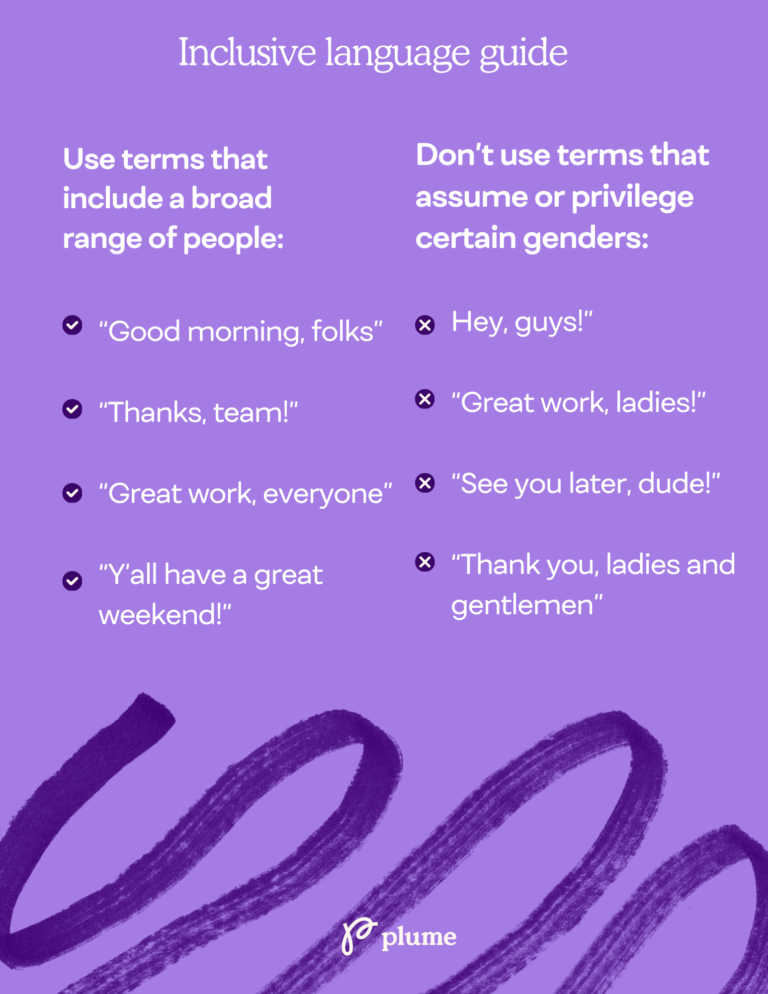
Using Chosen Names And Pronouns
It is important for employers to respect the name and pronouns that a transgender employee uses. This is not only a matter of respect, but it also helps to create an inclusive workplace culture that is safe and supportive of transgender employees. Employers should make sure that all employees are aware of the chosen name and pronouns of their transgender colleagues and that they are using them when addressing them. Employers should also make sure that their IT systems are updated to reflect the chosen name and pronouns of transgender employees.
It is also important for employers to recognize and respect the chosen name and pronouns of transgender employees in all of their communications, both internally and externally. This includes emails, newsletters, and other documents, as well as any public communications or press releases. Employers should also make sure that all of their employees are aware of the chosen name and pronouns of their transgender colleagues and that they are using them when addressing them.
Finally, employers should provide additional training to their managers and human resources staff on how to properly address and refer to transgender employees. This training should include information on how to use the chosen name and pronouns of transgender employees in all communications, as well as how to ensure that transgender employees are not singled out or discriminated against. It’s also worth noting that a trans person may or may not be publicly out as trans at work – if a trans person’s manager or HR knows that they’re planning to transition or have transitioned in the past, but the person’s coworkers don’t know, then the manager/HR must not disclose to others that the employee is trans without their permission. This is out of respect and safety.
Protecting Trans Employees’ Privacy
It is important for employers to protect the privacy of their transgender employees. Employers should ensure that any information that is shared with them about their transgender employees is kept confidential and is not shared with anyone outside of the organization. This includes any information related to the employee’s gender identity or expression, their chosen name and pronouns, and any medical or health information related to their gender transition. Employers should also create a policy that explicitly states that they will not disclose any information related to the gender identity or expression of their transgender employees. This policy should also state that any information that is shared with the employer about their transgender employees will be kept confidential and will not be shared with anyone outside of the organization.
It is also important for employers to ensure that their transgender employees are not singled out or discriminated against in any way. This includes ensuring that transgender employees are not asked any questions about their gender identity or expression in any job interviews or performance reviews. Employers should also make sure that their transgender employees are not excluded from any activities or opportunities that are open to other employees.
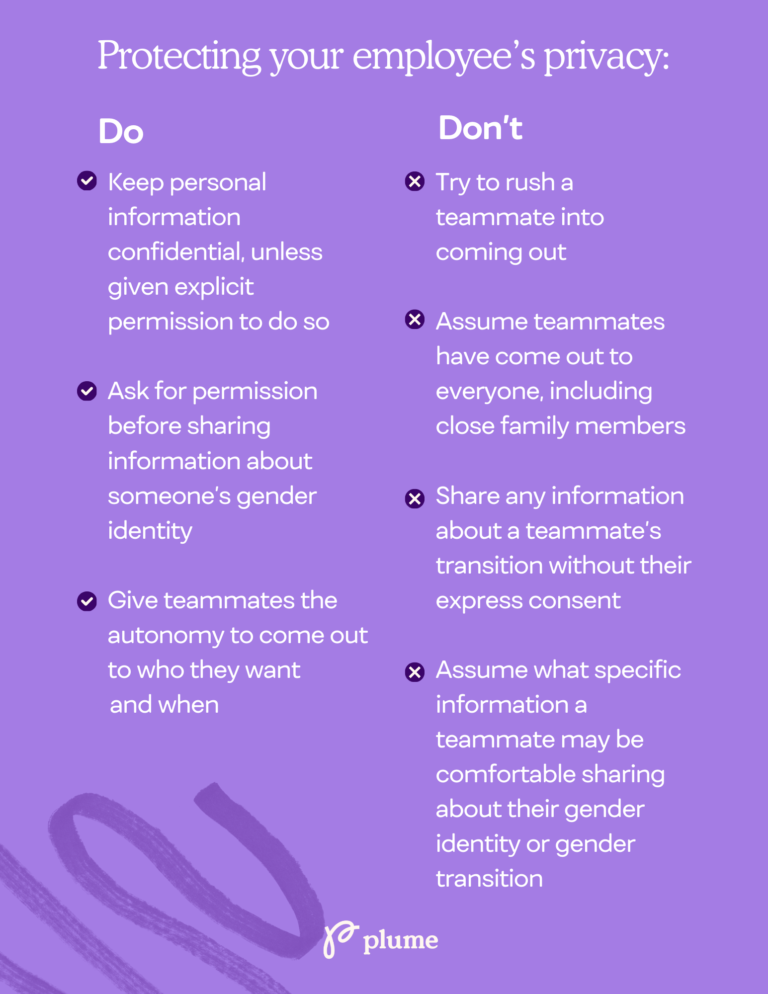
Protecting Trans Employees’ Rights
Employers must also make sure that their policies and procedures are effective in protecting transgender employees from harassment and discrimination. This includes having a clear policy that outlines the consequences for any form of harassment or discrimination based on gender identity or expression.
It’s also important for employers to provide transgender employees with a safe and confidential space to report any incidents of harassment or discrimination. This could include having a designated individual or team that is responsible for handling these types of complaints. Additionally, employers should ensure that their policies are regularly reviewed and updated to reflect the latest state and federal laws related to transgender rights. This will help ensure that the workplace remains a safe and supportive environment for all employees.
This includes having a clear policy that outlines the consequences for any form of harassment or discrimination based on gender identity or expression. Employers should also provide transgender employees with a safe and confidential space to report any incidents of harassment or discrimination. This could include having a designated individual or team that is responsible for handling these types of complaints.
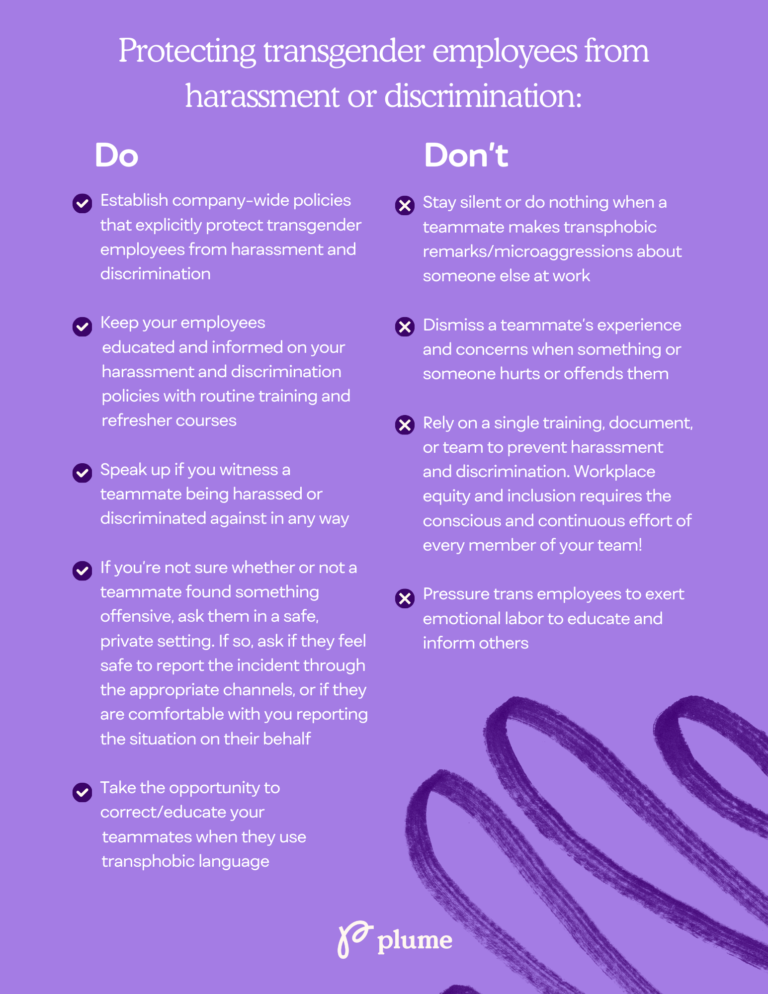
Nothing About Us, Without Us
It’s not enough for employers to simply have policies and procedures in place. In order to create a fully inclusive workplace, employers must ensure that transgender voices are heard in spaces where decisions are made about trans employees. This includes providing transgender employees with the opportunity to participate in conversations about policy changes and workplace initiatives.
It’s also important for employers to ensure that transgender employees have access to resources and support systems. This could include offering training or workshops on topics such as how to navigate the workplace as a transgender person or providing access to mental health services for transgender employees. Some other ways to do this are: Seek and include transgender perspectives in conversations regarding organizational policies and procedures. Provide a safe space for transgender employee feedback. Promote safe spaces for transgender team members to connect. This could include peer or community groups, Slack channels, and other spaces.
Gender-Inclusive Dress Code Policies
It is important for employers to create dress code policies that are gender inclusive and respectful of all gender identities and expressions.
This includes allowing transgender employees to dress in accordance with their gender identity or expression rather than the gender assigned to them at birth. Employers should also make sure that their dress code policies are not overly restrictive and that they allow employees to express their gender in a way that makes them feel comfortable and safe. Additionally, employers should ensure that their dress code policies are not discriminatory in any way. This includes avoiding any language that implies that there are only two genders and avoiding any dress code policies that are overly restrictive or that impose different standards for different genders. Employers should also ensure that their dress code policies do not single out any particular gender identity or expression and that they are applied equally to all employees.
Finally, employers should provide additional training to their managers and human resources staff on how to apply the dress code policies in a way that is respectful of all gender identities and expressions. This training should also include information on how to ensure that transgender employees are not singled out or discriminated against in any way.
Gender-Inclusive Facilities
It is important for employers to create access to facilities that are gender inclusive and respectful of all gender identities and expressions.
This includes providing gender-neutral restrooms, locker rooms, and other facilities that are accessible to all employees. Employers should also make sure that their facilities are clearly marked and that all employees are aware of which facilities are available for use. Additionally, employers should ensure that their facilities are private and secure and that transgender employees are not singled out or discriminated against in any way. This includes ensuring that transgender employees are not required to use any particular facility and that they are not subjected to any additional scrutiny or monitoring when using the facilities. Employers should also make sure that their facilities are regularly maintained and cleaned, and that any issues with the facilities are addressed as quickly as possible.
Finally, employers should provide additional training to their managers and human resources staff on how to ensure that all of their facilities are respectful and inclusive of all gender identities and expressions. This training should also include information on how to ensure that transgender employees are not singled out or discriminated against in any way.
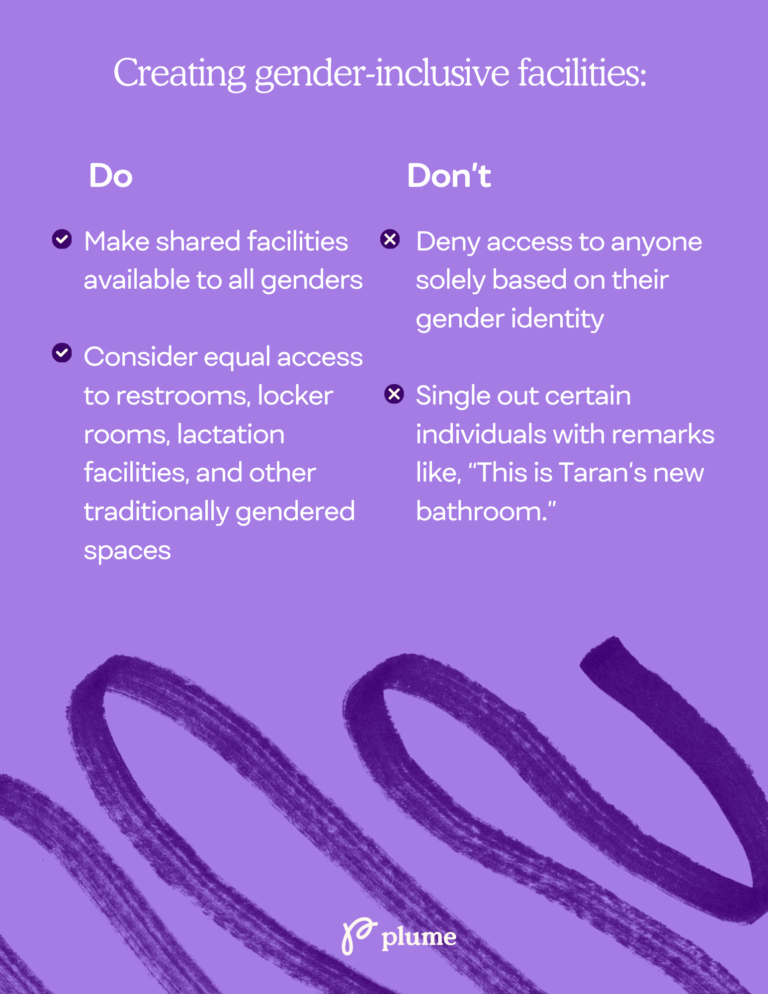
Remove Gender-Discriminatory Exclusions In Benefits
It is important for employers to remove any gender-discriminatory exclusions in their benefits plans.
This includes ensuring that transgender employees are not excluded from any health care coverage, parental leave policies, or other benefits that are available to other employees. Employers should also make sure that their benefits plans are not overly restrictive and that they provide coverage for gender-affirming healthcare. Additionally, employers should ensure that their benefits plans are not discriminatory in any way. This includes avoiding any language that implies that there are only two genders and avoiding any benefits plans that are overly restrictive or that impose different standards for different genders. Employers should also ensure that their benefits plans do not single out any particular gender identity or expression and that they are applied equally to all employees.
Finally, employers should provide additional training to their managers and human resources staff on how to ensure that their benefits plans are respectful and inclusive of all gender identities and expressions. This training should also include information on how to ensure that transgender employees are not singled out or discriminated against in any way.
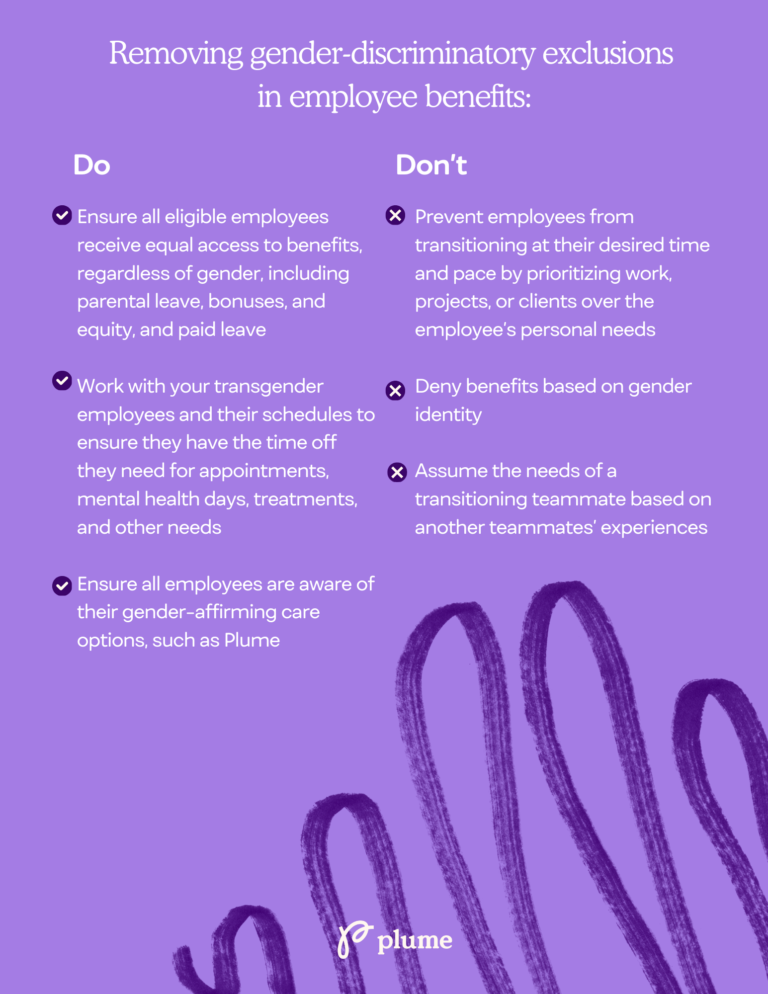
Stay Educated And Informed
Discrimination against any group of people is a serious issue, and the rights of transgender individuals in the workplace are no exception. It is essential that employers and their staff stay educated and informed about transgender anti-discrimination equality laws and policies. Knowing the laws and policies can help employers create a workplace environment that is safe, respectful, and welcoming for all employees. It can also ensure that transgender employees have the same rights and opportunities as their co-workers. Understanding the legal framework in which transgender rights are based can also help employers develop and implement policies that are both legally compliant and equitable. Staying informed and educated on the subject of transgender anti-discrimination equality laws and policies is an essential step in creating and maintaining an inclusive, diverse workplace.
It is essential for employers to stay informed about the latest state and federal laws related to transgender rights and protections. This includes laws such as the Equality Act, which prohibits discrimination based on gender identity and expression in employment, housing, and public accommodations. It’s also important to be aware of state-specific laws, such as those that protect transgender students from discrimination in schools. These laws can provide valuable insight into how employers can create a more inclusive workplace for their transgender employees. Finally, employers should also stay informed about the latest case law related to transgender rights. This can help employers make sure that their policies and procedures are in compliance with the latest legal standards.
The Human Rights Campaign provides a wealth of information and resources on transgender inclusion in the workplace, including a guide for employers on creating policies and procedures that are compliant with the latest state and federal laws related to transgender rights. The National Center for Transgender Equality also provides a wide range of resources on transgender rights and protections, including information on how to create a workplace environment that is inclusive of transgender employees. Other resources that Plume recommends for policy, employment, and legal resources are:
- Model Transgender Employment Policy
- Transgender ID Documents Center
- Protections Against Employment Discrimination Based on Sexual Orientation or Gender Identity
Conclusion
Increasingly, transgender workers are becoming a more visible part of the workforce in the United States. While many transgender, nonbinary, and gender non-conforming people still face isolation, harassment, and discrimination, there are many employers who are making an effort to be welcoming and supportive. You can use this guide to learn why it is important to identify some ways employees can be protected from discrimination based on their gender identity in the workplace.
The major barrier for these employees is often a lack of education and understanding about their rights. When employees are not provided with the tools and resources necessary to navigate workplace discrimination and harassment, or when they do not know how to respond when they experience it, they can feel isolated and vulnerable. By taking the necessary steps to create a safe and welcoming workplace environment and by educating yourself and your team about transgender employees, you can help to create an environment that is free from discrimination and harassment.




